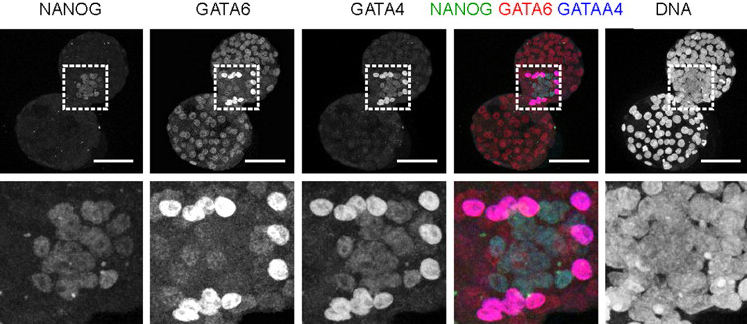Differences between mammals begin early in development
Posted by Erin M Campbell, on 8 March 2012
 The progress of stem cell research depends on the ability to grow stem cells in culture. Embryonic stem (ES) cells from some organisms, such as humans, have proven difficult to culture. While it is known that there are differences in early development between even closely-related species, understanding where these differences begin will help biologists understand how to culture other ES cells, and will contribute to our understanding of pre-implantation development. A recent paper in Development helps sort out some of these nuances.
The progress of stem cell research depends on the ability to grow stem cells in culture. Embryonic stem (ES) cells from some organisms, such as humans, have proven difficult to culture. While it is known that there are differences in early development between even closely-related species, understanding where these differences begin will help biologists understand how to culture other ES cells, and will contribute to our understanding of pre-implantation development. A recent paper in Development helps sort out some of these nuances.
Before implantation, an early mammalian embryo has already formed three distinct cell lineages. First, the trophectoderm lineage is segregated from cells of the inner cell mass, and will contribute to the placenta. Within the inner cell mass, the hypoblast precursors, which contribute to the yolk sac, are segregated from the epiblast precursors, which will become the actual embryo. In mice, the segregation of hypoblast and epiblast lineages is regulated by FGF/MAP kinase signaling, and inhibition of MEK signaling prevents ES cells from differentiating. Despite this knowledge of mouse early development and embryonic stem cells, human ES cells remain difficult to culture. Kuijk and colleagues recently published work describing the differences in the signaling involved in hypoblast and epiblast lineage segregation in both human and bovine cultured embryos. Specifically, bovine embryos with stimulated FGF and heparin levels had only hypoblast cells but no epiblast cells, and MEK inhibition resulted in more epiblast cells and fewer hypoblast cells. That hypoblast cells were not completely ablated after MEK inhibition indicates that other signaling is important in hypoblast differentiation. Interestingly, MEK inhibition of early human embryos did not affect the numbers of hypoblast and epiblast cells. Images above are of an early human embryo, immunostained for NANOG (to mark early epiblast cells) and GATA4/6 (to mark early hypoblast cells). At this point in development (day 6), the epiblast precursors are surrounded by hypoblast precursors, indicating that the physical separation of the cell lineages has occurred.
For a more general description of this image, see my imaging blog within EuroStemCell, the European stem cell portal.
![]() Kuijk, E., van Tol, L., Van de Velde, H., Wubbolts, R., Welling, M., Geijsen, N., & Roelen, B. (2012). The roles of FGF and MAP kinase signaling in the segregation of the epiblast and hypoblast cell lineages in bovine and human embryos Development, 139 (5), 871-882 DOI: 10.1242/dev.071688
Kuijk, E., van Tol, L., Van de Velde, H., Wubbolts, R., Welling, M., Geijsen, N., & Roelen, B. (2012). The roles of FGF and MAP kinase signaling in the segregation of the epiblast and hypoblast cell lineages in bovine and human embryos Development, 139 (5), 871-882 DOI: 10.1242/dev.071688


 (2 votes)
(2 votes)